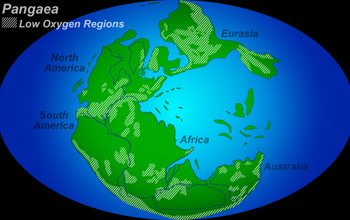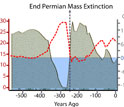|

Press Release 05-058
Reduced Oxygen Contributed To “Great Dying”

Oxygen deficiency could also account for the delayed recovery of species diversity
April 14, 2005
New research suggests that low atmospheric oxygen levels had already increased extinction rates prior to the massive animal and plant extinctions 251 million years ago. Furthermore, reduced oxygen likely contributed to the protracted recovery from the catastrophic event.
Based on predicted oxygen levels in the late Permian and early Triassic periods--the timeframe spanning the great extinctions--Raymond Huey and Peter Ward at the University of Washington simulated on a computer the combined effects of reduced oxygen and topography on a set of hypothetical species representative of the period.
The scientists, whose work is supported by the National Science Foundation (NSF), published their findings in the April 15 issue of the journal Science.
As atmospheric oxygen decreased in the late Permian period, hypoxia, or insufficient oxygen in bodily tissue, would have become an undeniable problem for Earth's terrestrial species. Huey and Ward predicted that eventually, because oxygen levels decrease as altitude increases, only land near sea level would have been habitable on the relatively new supercontinent of Pangaea. As a result of this so-called "altitudinal compression," even modestly high mountains would have represented insurmountable barriers that prevented intermingling and reproduction between nearby populations.
These results could force paleontologists to re-evaluate the accepted notion that Pangaea was like a "superhighway" for species movement, as its mountain ranges may have impeded movement and drastically affected species development.
William Zamer, a manager in NSF's program for Integrative and Organismal Biology said, "Huey and Ward have produced a novel and insightful study linking the effects of a low-oxygen atmosphere with the possible biogeographic and evolutionary consequences on terrestrial animals during the Permian extinction."
For more details, see the University of Washington's news release.
-NSF-

Media Contacts
Richard (Randy) Vines, NSF (703) 292-7983 rvines@nsf.gov
Principal Investigators
Raymond Huey, University of Washington (206) 543-1505 hueyrb@u.washington.edu

The National Science Foundation (NSF) is an independent federal agency that supports fundamental research and education across all fields of science and engineering. In fiscal year (FY) 2009, its budget is $9.5 billion, which includes $3.0 billion provided through the American Recovery and Reinvestment Act. NSF funds reach all 50 states through grants to over 1,900 universities and institutions. Each year, NSF receives about 44,400 competitive requests for funding, and makes over 11,500 new funding awards. NSF also awards over $400 million in professional and service contracts yearly.
 Get News Updates by Email Get News Updates by Email
Useful NSF Web Sites:
NSF Home Page: http://www.nsf.gov
NSF News: http://www.nsf.gov/news/
For the News Media: http://www.nsf.gov/news/newsroom.jsp
Science and Engineering Statistics: http://www.nsf.gov/statistics/
Awards Searches: http://www.nsf.gov/awardsearch/
| 


